Discover 35 hidden attractions, cool sights, and unusual things to do in Białystok (Poland). Don't miss out on these must-see attractions: Podlaskie Museum, Branicki Palace, and Planty Park. Also, be sure to include Kościuszko Square in your itinerary.
Below, you can find the list of the most amazing places you should visit in Białystok (Podlasie).
Table of Contents
Podlaskie Museum
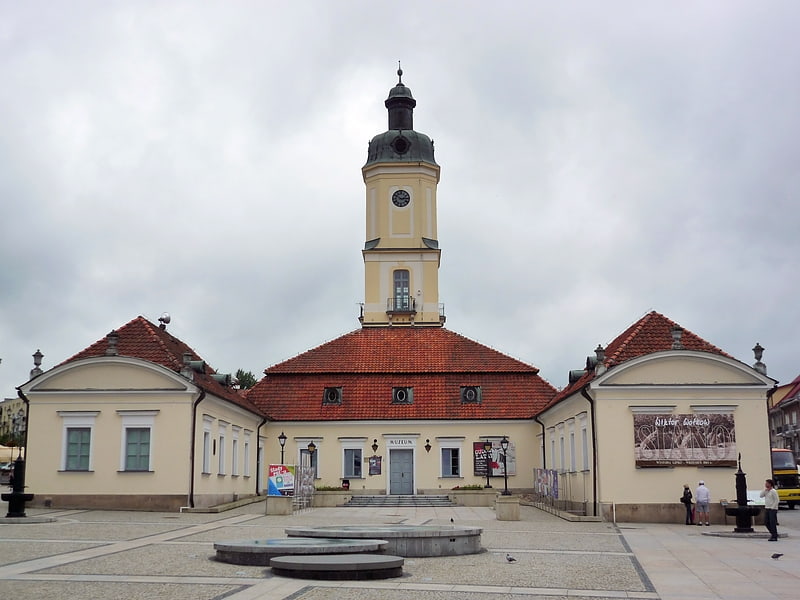
Podlaskie Museum in Białystok is a museum which is based in Białystok the capital of Podlaskie Voivodeship in north-eastern Poland with affiliates in Bielsk-Podlaski.[1]
Address: Ratusz, Rynek Kościuszki 10, Białystok
Branicki Palace
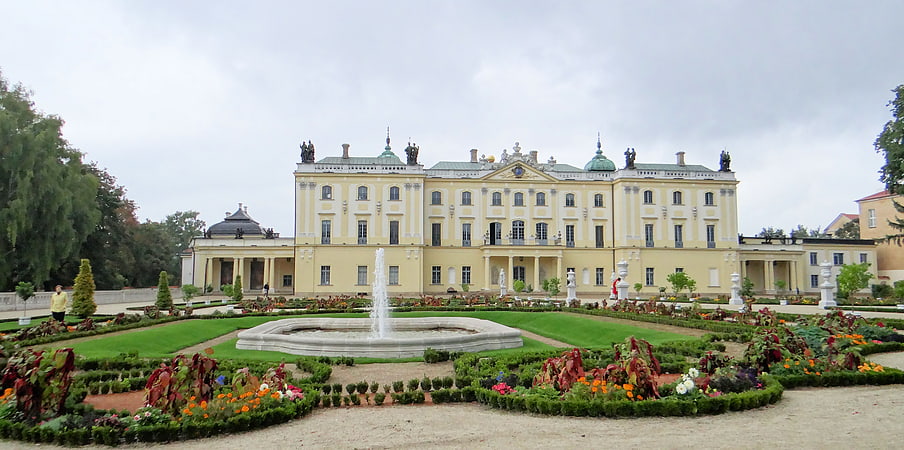
Also known as: Pałac Branickich w Białymstoku
Baroque palace and medical history museum. Branicki Palace is a historical edifice in Białystok, Poland. It was developed on the site of an earlier building in the first half of the 18th century by Jan Klemens Branicki, a wealthy Polish–Lithuanian Commonwealth hetman, into a residence suitable for a man whose ambition was to become king of Poland. The palace complex with gardens, pavilions, sculptures, outbuildings and other structures and the city with churches, city hall and monastery, all built almost at the same time according to French models was the reason why the city was known in the 18th century as Versailles de la Pologne and subsequently Versailles de la Podlachie.[2]
Address: Jana Kilińskiego 1, 15-089 Białystok
Planty Park
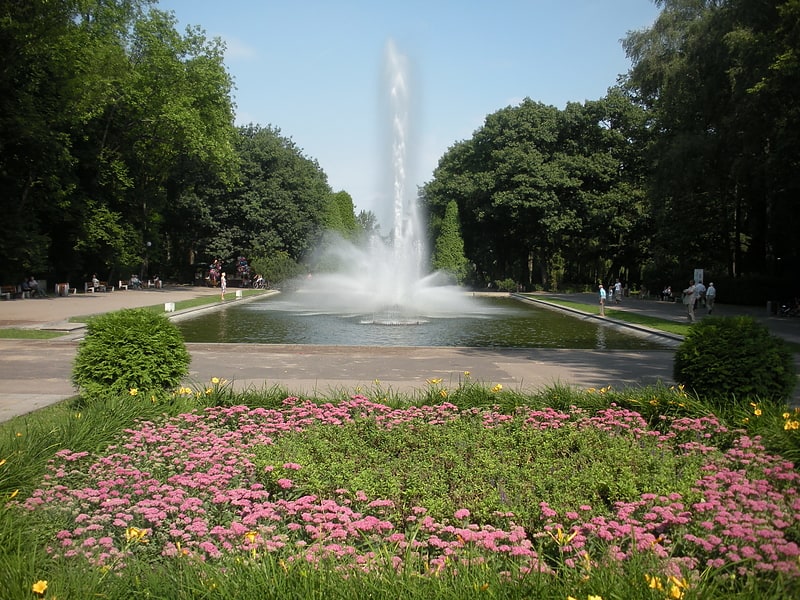
Planty Park is a city park in Białystok with an area of 14.94 ha. It connects the May 3 Constitution Park with the Poniatowski Park.[3]
Kościuszko Square
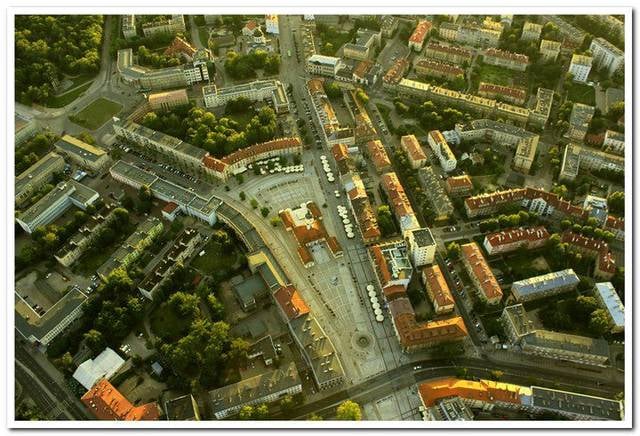
Kościuszko Square is the representative and central square of Białystok, capital of Podlaskie Voivodeship in north-eastern Poland.[4]
Address: Rynek Kościuszki 10, Białystok
Białystok Cathedral
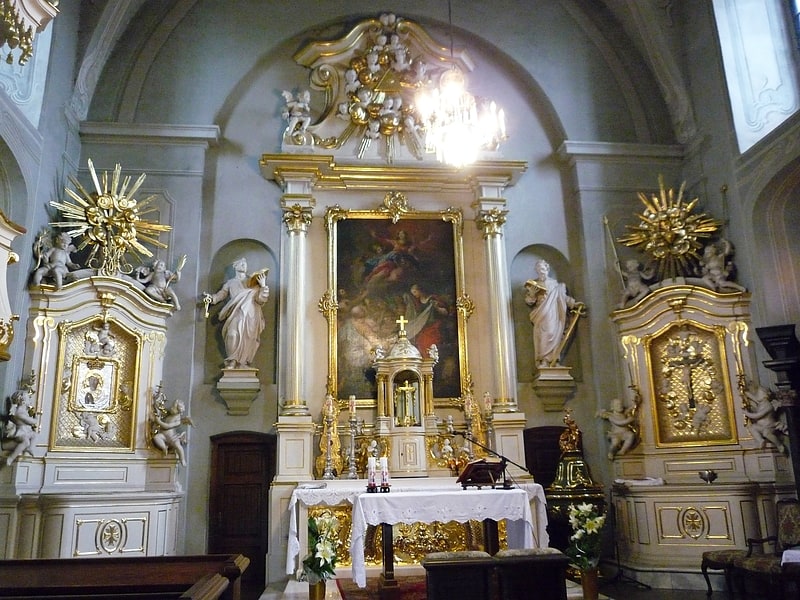
Also known as: Bazylika archikatedralna Wniebowzięcia Najświętszej Maryi Panny w Białymstoku
Catholic cathedral in Białystok, Poland. The Cathedral Basilica of the Assumption of the Blessed Virgin Mary also called Białystok Cathedral is a Roman Catholic cathedral in the city of Bialystok in Poland. It was designed by architect Józef Pius Dziekoński. The three-nave church is 90 meters long and can accommodate 9,500 worshipers. The two towers reach 72.5 meters high. It is the main church of the Archdiocese of Bialystok and acquired the status of basílica in 1985 by decision of Pope John Paul II.
The predecessor of the present cathedral was a Renaissance church was built between 1617 and 1626. In the late 19th century, the number of parishioners had grown to 12,000 people, while the old church was only room for 1,000 worshipers. The Catholics under Czarist Russia were not allowed to build a new church. However, permission was obtained to increase the old parish church. In 1900 they started next to the old church building a neo-Gothic church, designed by Józef Pius Dziekoński. On 17 September 1905, the church was consecrated by the Bishop of Vilnius.
Between 1996 and 2004 the church was restored.[5]
Address: ul. Koscielna 2, 15-087 Bialystok
Orthodox Cathedral of St. Nicholas
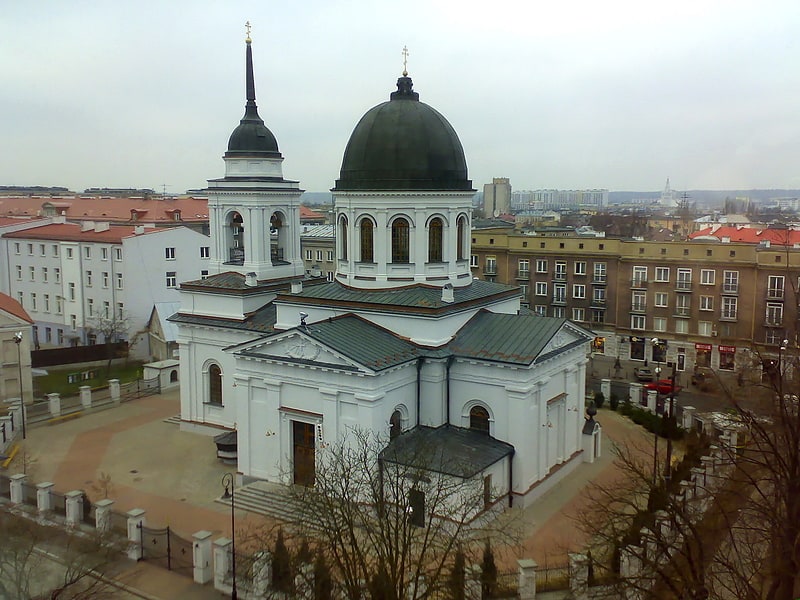
The Orthodox Cathedral of St. Nicholas in Białystok is an historic Orthodox cathedral in Bialystok, Poland
St. Nicholas is the cathedral of the Bialystok-Gdańsk diocese of the Polish Autocephalous Orthodox Church and the seat of the Bialystok parish of St. Mikołaj (in the deanery of Białystok). It is the largest Orthodox cathedral in the city.
The current St. Nicholas building was erected between 1843 and 1846 on the site of an Uniate church from the early 18th century. St. Nicholas was consecrated as a church by the Vilnius and Lithuanian metropolitan Józef. During the interwar period, St Nicholas was one of two Orthodox churches in Bialystok.
In 1951, St. Nicholas became the cathedral of the Białystok-Gdańsk diocese. Since 1992, the cathedral has been the resting place of the relics of Gabriel of Białystok.
The cathedral building represents the classical style, typical of the church architecture of the Russian Empire in the late 18th century and the early 19th century.
The cathedral is located in the center of Białystok at Lipowa Street 5. It entered in the register of monuments on January 24, 1957, under the number A-200.[6]
Address: 15 Lipowa, Białystok
Museum of Folk Culture
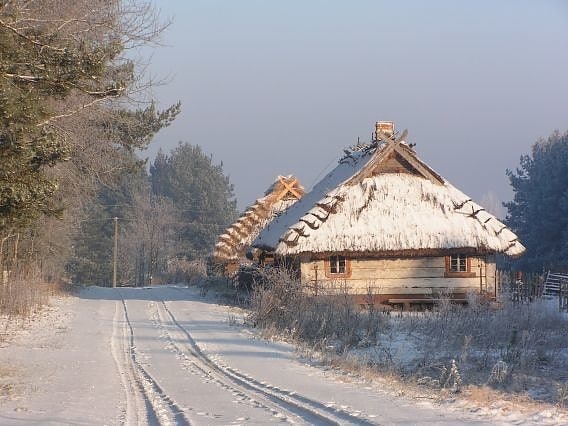
Podlaskie Museum of Folk Culture is an open-air museum, gathering monuments of wooden architecture and ethnographic collections from the Bialystok, Lomza and Suwalki regions. Established from the merger of the Białystok Village Museum and the Ethnography Department of the Podlaskie Museum, previously it was a branch of the Museum.
The museum is located at the northern borders of Białystok, in the settlement of Wasilków, on the road to Augustów.[7]
Address: Ul. Leśna 7, Białystok
Aleksandr Węgierki Drama Theatre

The Aleksander Węgierko Drama Theatre in Białystok is a repertory theatre in Białystok, established in 1938. It was founded by actor Aleksander Węgierko.[8]
Address: 12 Elektryczna, Białystok
Białystok Puppet Theatre
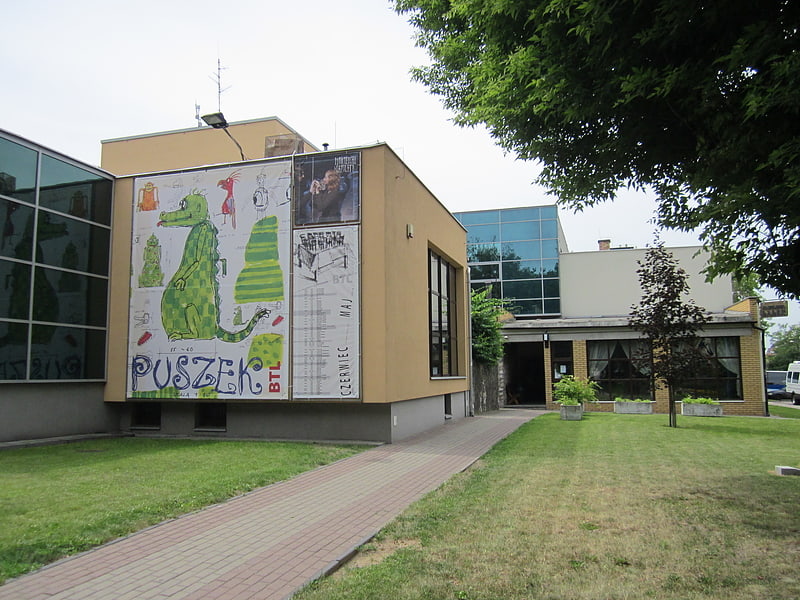
Bialystok Puppet Theatre, founded in 1953, is one of the oldest puppet theaters in Poland. Its repertoire consists mainly of puppetry-based adaptations of international literature, as well as children's entertainment.[9]
Address: 1 Konstantego Kalinowskiego, Białystok
Piaskower Synagoge

Synagogue. The Piaskower Synagoge is a former synagogue in Białystok, Podlaskie Voivodeship, Poland, on 3 Piękna street in the Piaski district, from which it takes its name.
The synagogue was constructed from 1891 to 1893 on the site of an earlier wooden synagogue which had been built around 1820. During the German occupation of Poland in the Second World War, it was partially destroyed. From 1945 to 1968, it was the seat of various Białystok Jewish organisations, such as the Socio-cultural Association of Jews in Poland. From 1968, the building was no longer used for specifically Jewish purposes, instead being used as a cinema and a theatre. Renovation work in the 1970s removed the distinctive features that marked it as a synagogue and it burnt down in 1989.
In 1995, the structure was renovated. It is currently the headquarters of the Ludwik Zamenhof Foundation, which sells text-books and literature on Esperanto and offers Esperanto language courses.[10]
Address: 1 Piękna, Białystok
St. Roch's Church
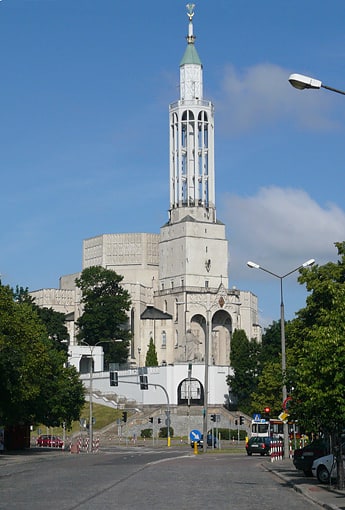
Also known as: Bazylika św. Rocha w Białymstoku
Catholic church in Białystok, Poland. St. Roch Roman Catholic Church in Białystok, Poland was built between 1927 and 1946 in a modernistic style, designed by renowned Polish architect, professor Oskar Sosnowski. Its official name is Church - Monument of Poland's Regained Independence and it stands on the Saint Roch hill on Lipowa Street in Bialystok, in the spot where a Roman Catholic cemetery, founded in 1839, once stood. The cemetery was profaned by the Russians during the January Uprising.
The church was built on initiative of local provost, reverend Adam Abramowicz, who in April 1926 announced competition for the design of a new complex. Seventy entries were sent, with the design of professor Sosnowski winning. The church is planned as an octahedron, with three masses set on one another. The first mass makes the main part of the complex, the additional two are located on the sides, making the attics. Originally, the church was commemorated to Mary, symbolized with a star, therefore Sosnowski used stars in his design, especially in elements of the vault. After his death (September 1939, during German siege of Warsaw), the construction was continued by another architect, Stanislaw Bukowski. During the Soviet occupation of eastern Poland during World War II (September 1939 - June 1941), Soviet authorities planned to open a circus in the unfinished building.
The church has an impressive, 83-meter tower, which is modeled after that of the Cathedral in Kamianets-Podilskyi. On the top, there is a 3-meter figure of Mary, which stands on a Piast-style crown. The vaults resemble traditional vaults found in houses of northeastern part of Poland. Near the church there is a rectory, also designed by Sosnowski. The whole complex is surrounded by walls, in reference to the tradition of fortified churches, common in eastern Poland.[11]
The Ludwik Zamenhof Centre
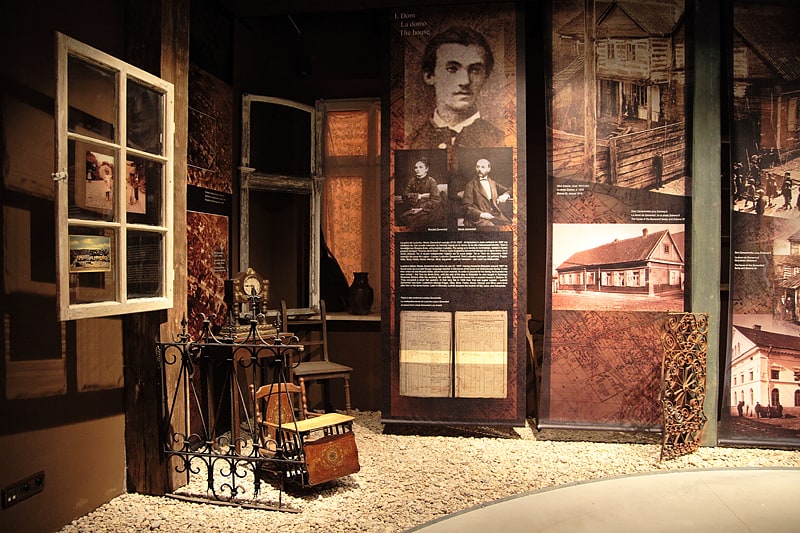
Also known as: Centrum im. Ludwika Zamenhofa w Białymstoku
Cultural institute in Białystok, Poland. The Ludwik Zamenhof Centre is a city cultural institution established in Bialystok at 19 Warszawska St. upon the motion of the President of the City. It was founded to celebrate the organization of the 94th World Congress of Esperanto that was held from 25 July to 1 August 2009 in Bialystok. The Centre was officially opened for the visitors on 21 July 2009. At the beginning The Zamenhof Centre was a branch of The Centre of Culture in Bialystok, but it has been an autonomous cultural unit since January 2011.
The Zamenhof Centre offers the visitors a permanent exhibition - Bialystok of Young Zamenhof – and various temporary exhibitions, concerts, film projections, and theatre performances. Moreover, the Centre regularly holds panel discussions, lectures, and literary promotions.
The Zamenhof Centre organises also numerous educational workshops for children and teenagers and introduces modern social and educational projects, such as Living Library and „Discover Bialystok” – an outdoor game realised in the urban area of the city.[12]
Divine Mercy Sanctuary
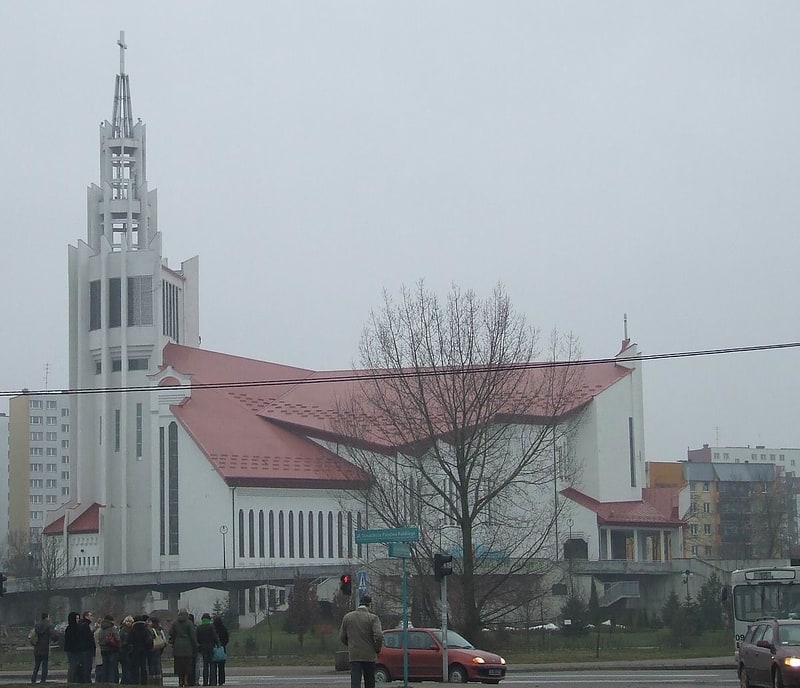
Also known as: Sanktuarium Miłosierdzia Bożego w Białymstoku
Divine Mercy Sanctuary in Białystok is a church in the district of Białostoczek at the Radzymińska Street 1.[13]
Address: 1 Radzymińska, Białystok
VI High School – King Sigismund Augustus
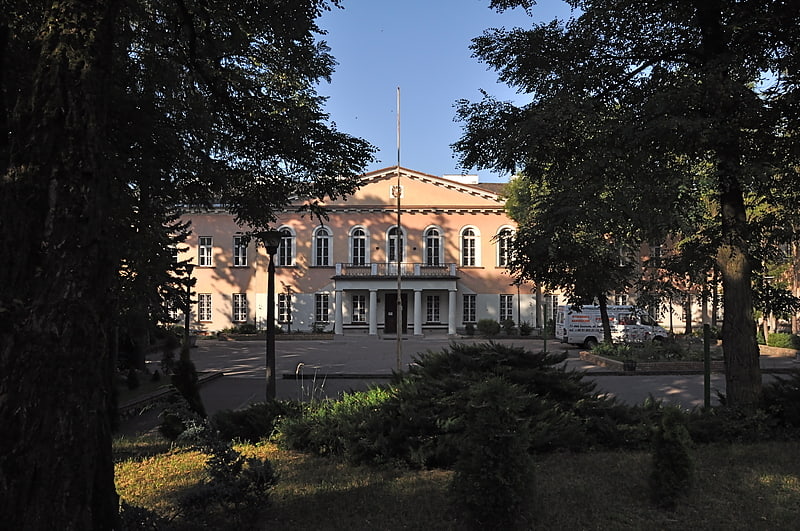
VI High School – King Sigismund Augustus is a secondary school in the Bojary district of the city of Białystok in Poland. The school was founded in 1915 and its alumni include the inventor of Esperanto. The school is named after the sixteenth century King Sigismund II Augustus.
The school was based in buildings that were the Realschule in the city. This school had started much earlier and was attended by L. L. Zamenhof from 1869 to 1871 when his family then moved to Warsaw. The other famous person who attended the school was Ignacy Hryniewiecki, the assassin of the Tzar of Russia Alexander II.
120 students from this school were involved in the Polish fight for independence in 1917-20.
In 2008, the school was opened as part of a Jewish Heritage Trail organised by local university students.[14]
Monument to World War II Orthodox victims
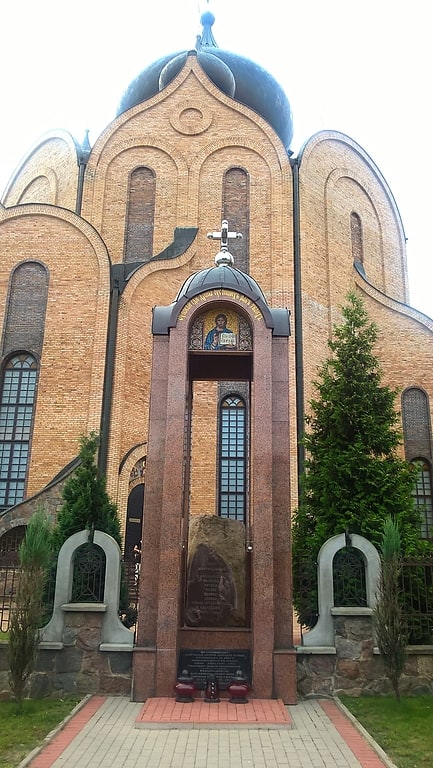
Also known as: Pomnik prawosławnych mieszkańców Białostocczyzny zabitych i zaginionych w latach 1939–1956
Monument in Białystok, Poland. Monument to World War II Orthodox victims in Białystok is a privately funded memorial commemorating the memory of 5,000 Orthodox Christians from the Białystok region who perished in World War II as well as, during the postwar repressions in Stalinist Poland.[15]
Army Museum
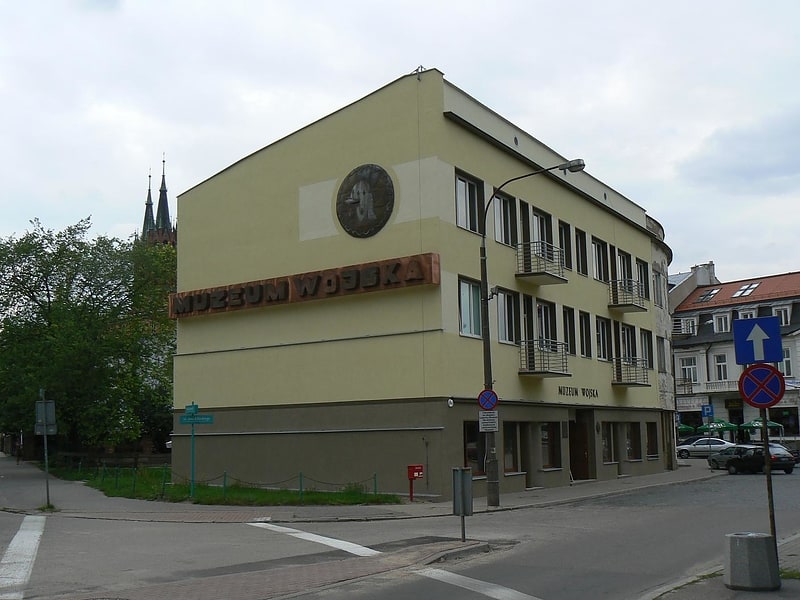
Museum of the Army in Bialystok - a military museum established in September 1968 as a branch of the District Museum, since 1976 it has functioned as an independent museum unit of macro-regional scope. Currently it is a local government cultural institution of the city of Białystok.
As part of the Army Museum until the end of 2016, there was a branch - the Sibir Memorial Museum.
Address: Ul. Jana Kilińskiego 7, Białystok
Muzeum Rzeźby Alfonsa Karnego
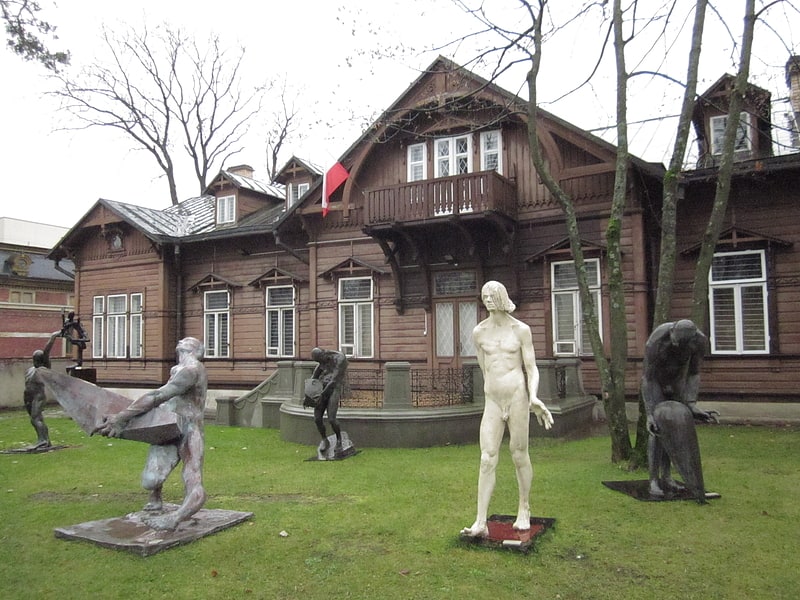
Alfons Karny Museum of Sculpture - a biographical museum of Alfons Karny, located in the historic wooden villa of General von Driesen in Bialystok. It collects works of the sculptor, documents the artist's artistic activity, organizes exhibitions of contemporary art in the field of painting, sculpture, graphics, and photography, and conducts educational activities with particular emphasis on the needs of the visually and hearing impaired and those with intellectual disabilities.
Permanent exhibitions: Portraits of Great Poles, Sculptor's Studio, History of Creative Life, Old and Contemporary Art from the Artist's Collection.
Address: Świętojańska 17, Białystok
Muzeum Historyczne
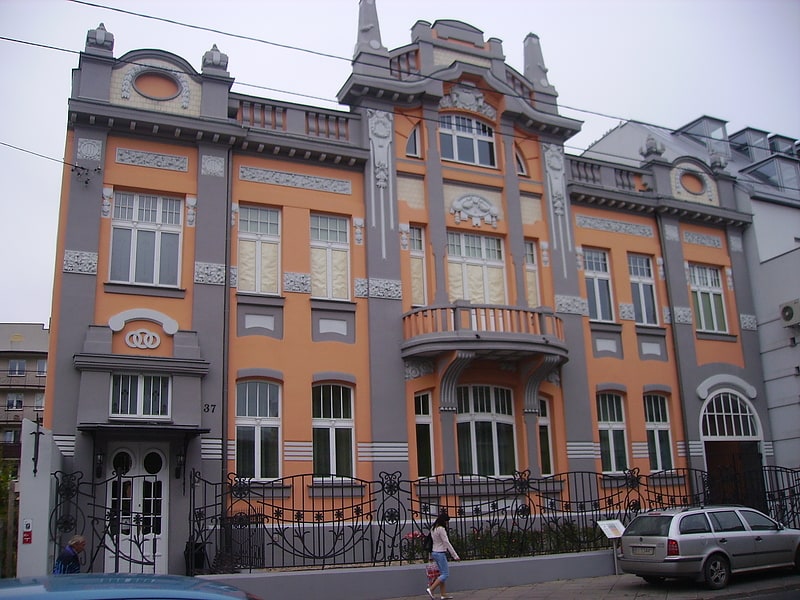
The Historical Museum in Bialystok is part of the Podlaskie Museum. It has a rich collection of archival and iconographic items illustrating the past of Bialystok and Podlasie, as well as a number of bourgeois cultural relics, especially of applied crafts. There is also a Numismatic Cabinet with a collection of 20,000 coins, medals, and securities. The Museum is in possession of the only collection in the country of memorabilia connected with the Tatar settlement in the Polish-Lithuanian-Belarusian borderland.
Address: Warszawska 37, 15-077 Białystok
Osiedle Centrum
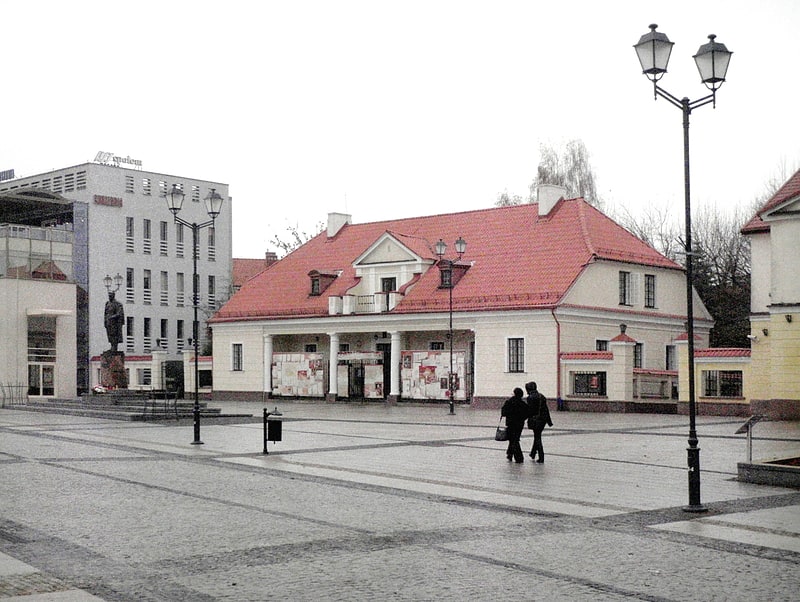
Also known as: Centrum
Osiedle Centrum is the oldest, central, representative district of the Polish city of Białystok.[16]
Osiedle Wygoda

Wygoda is one of the districts of the Polish city of Białystok, located north and north-east of the historic city center.[17]
Osiedle Wysoki Stoczek
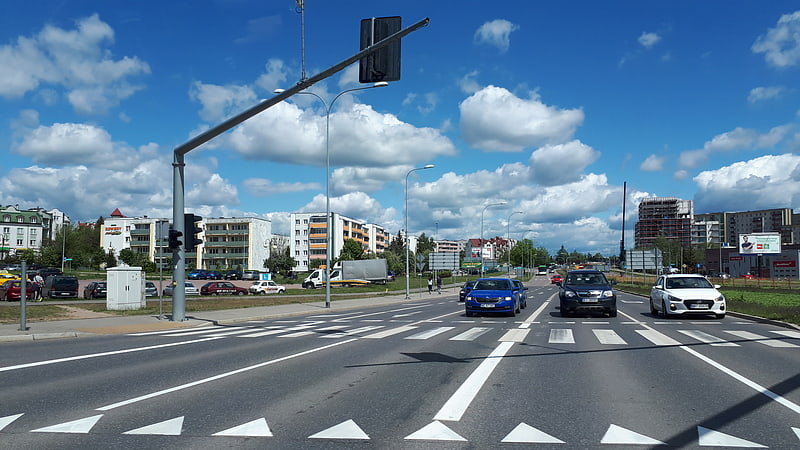
Wysoki Stoczek is one of the districts of Białystok in Poland.[18]
Galeria Arsenał
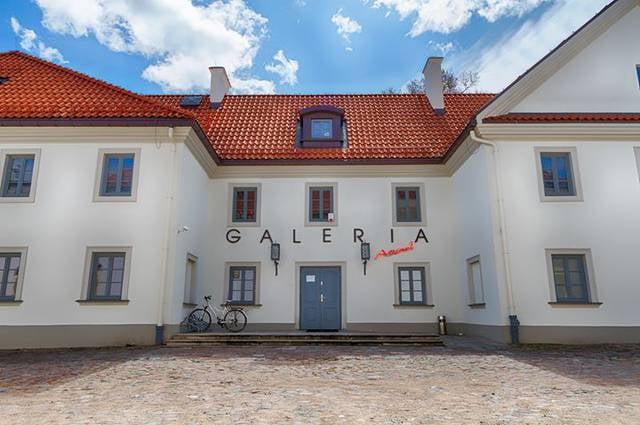
Arsenal Gallery in Bialystok is a Polish contemporary art gallery that was established in 1965 as one of the Bureaus of Art Exhibitions.
Address: Adama Mickiewicza 2, 15-004 Białystok
Opera i Filharmonia Podlaska - Europejskie Centrum Sztuki

Podlaska Opera and Orchestra in Białystok is a cultural institution in Bialystok, capital of Podlaskie Voivodeship of Poland. It is the largest artistic institution in north-eastern Poland and the most modern cultural center in this part of Europe.[19]
Address: Odeska 2, Białystok
Podlaskie Muzeum Kultury Ludowej - Skansen

Podlaskie Museum of Folk Culture is an open-air museum, gathering monuments of wooden architecture and ethnographic collections from the Bialystok, Lomza and Suwalki regions. Established from the merger of the Białystok Village Museum and the Ethnography Department of the Podlaskie Museum, previously it was a branch of the Museum.
The museum is located at the northern borders of Białystok, in the settlement of Wasilków, on the road to Augustów.[20]
Osiedle Bojary
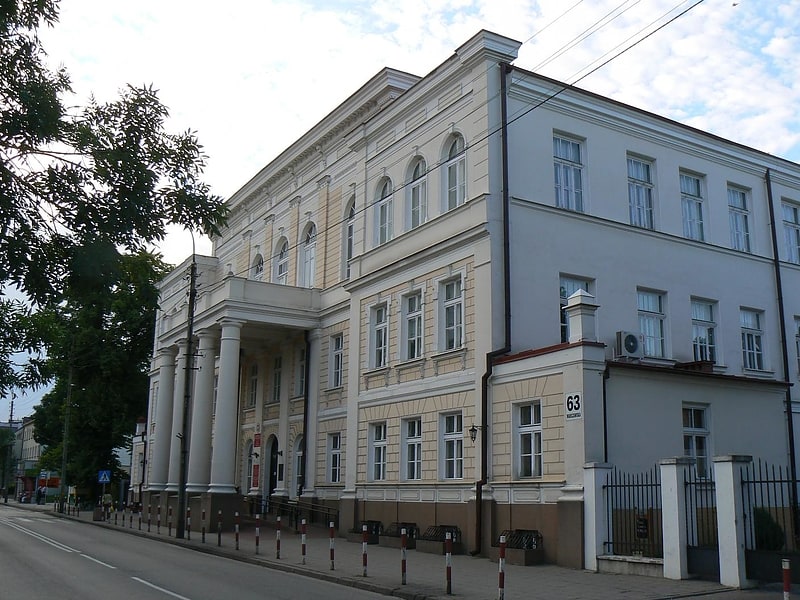
Also known as: Bojary
Bojary is one of the districts of the Polish city of Białystok.[21]
Pałac Hasbacha
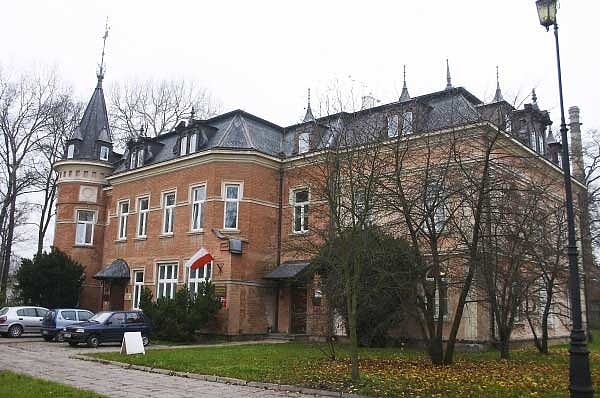
Hasbach Palace - the residence of Ewald Hasbach, a Bialystok factory owner who owned a nearby weaving mill that was converted into a dye factory after World War I. The palace is located in the Dojlidy district at the intersection of Rev. The palace is located in Dojlidy district, at the intersection of Ks. Stanislaw Suchowolca, Dojlidy Fabryczne and Myśliwska streets.
Address: 23 Dojlidy Fabryczne, Białystok
Cerkiew Świętego Ducha
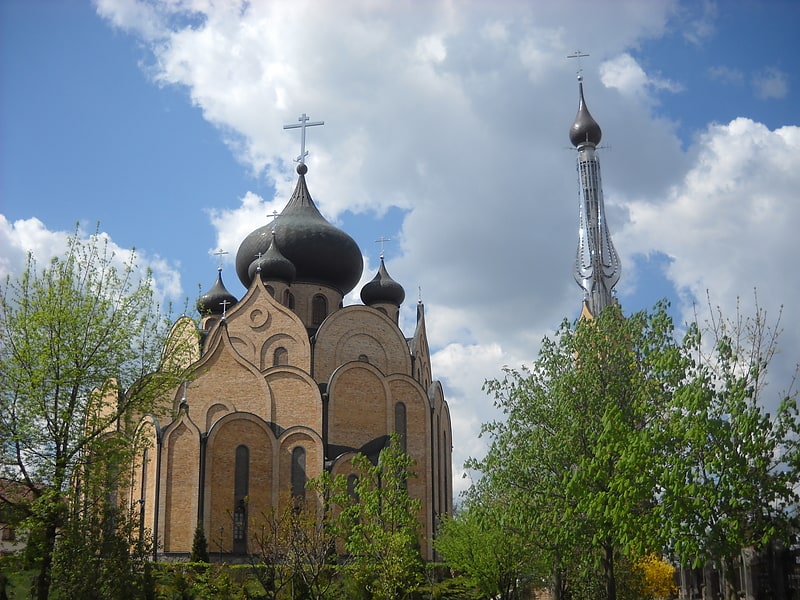
Church of the Holy Spirit - an Orthodox parish church in Bialystok. It belongs to the Bialystok decane of the Bialystok Diocese of the Polish Autocephalous Orthodox Church. It is located in the High Stoczek district, at 13 Antoniuk Fabryczny Street.
Designed by Jan Kabac, built since the 80s of the 20th century and consecrated in 1999, the temple is the largest Orthodox church in Poland. It is a one-nave and five-domed building with two altars. The external appearance of the building refers to the name of the church. The interior is modern, but based on traditional patterns of Orthodox church art. The frescos were painted by a team of iconographers from Donetsk under the direction of Volodymyr Telichko.
Address: 13 Antoniuk Fabryczny, Białystok
Park Centralny
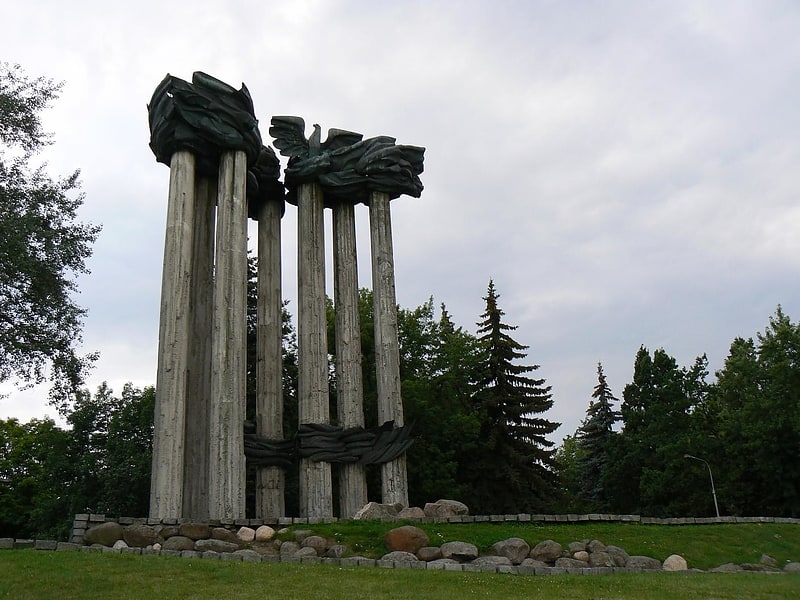
Central Park - an urban park in Bialystok with an area of 3.27 hectares located in the center of the city, located in the area of Kijowska, Sosnowa, K. Kalinowskiego, J. Mariański and the Square of the Independent Students' Association.
Osiedle Białostoczek
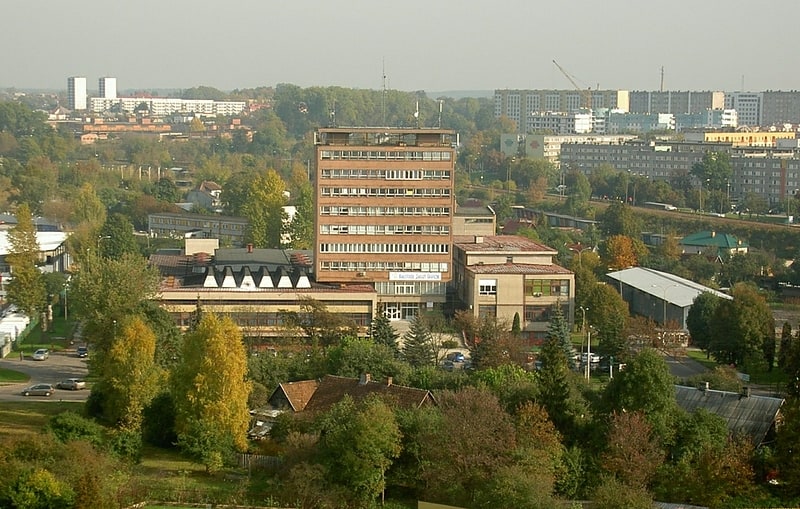
Białostoczek is a district of the City of Białystok, Poland. It is a mixed residential and industrial area. Prior to its incorporation into the city in 1919, it was a separate village.[22]
Ogród Zoologiczny Akcent w Białymstoku
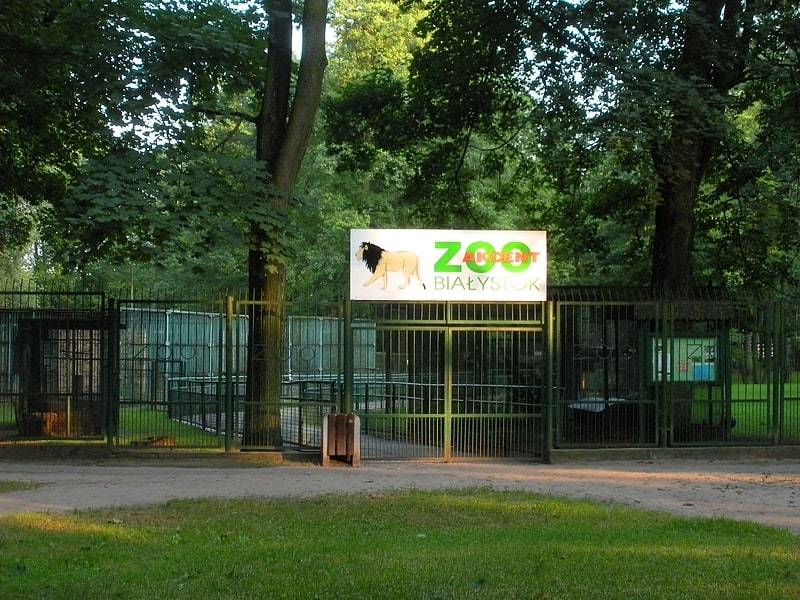
Accent Zoo in Bialystok - a zoo located within the 3 hectare Constitution Park. It was opened in the 1960s. For many years, the zoo was administered by the Zieleń Miejska company. The current administrator is the Animal Shelter in Białystok.
Address: Podleśna 4, 15-227 Białystok
Cerkiew Świętego Jerzego
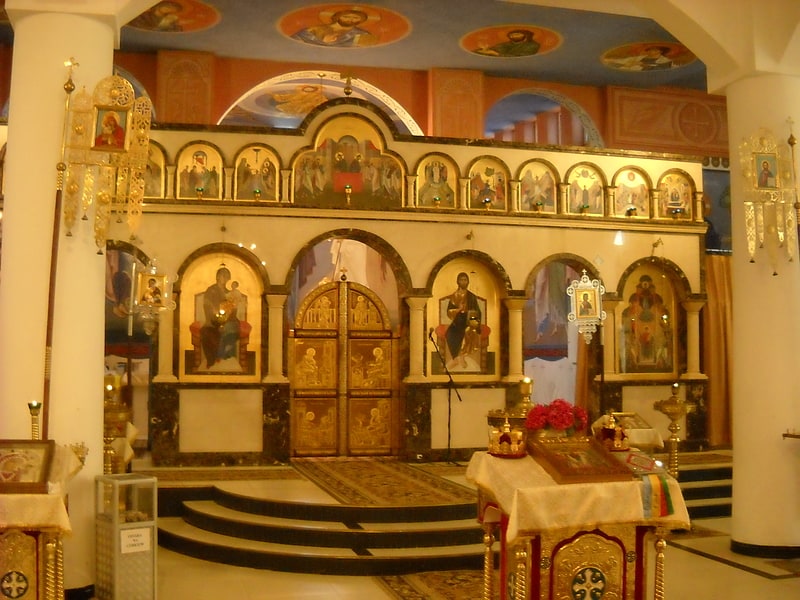
St. George Orthodox Church - an Orthodox parish church in Bialystok. It belongs to Bialystok deanery of Bialystok diocese of the Polish Autocephalous Orthodox Church.
Address: Kazimierza Pułaskiego 36, 15-338 Białystok
Kościół pw. Świętej Jadwigi
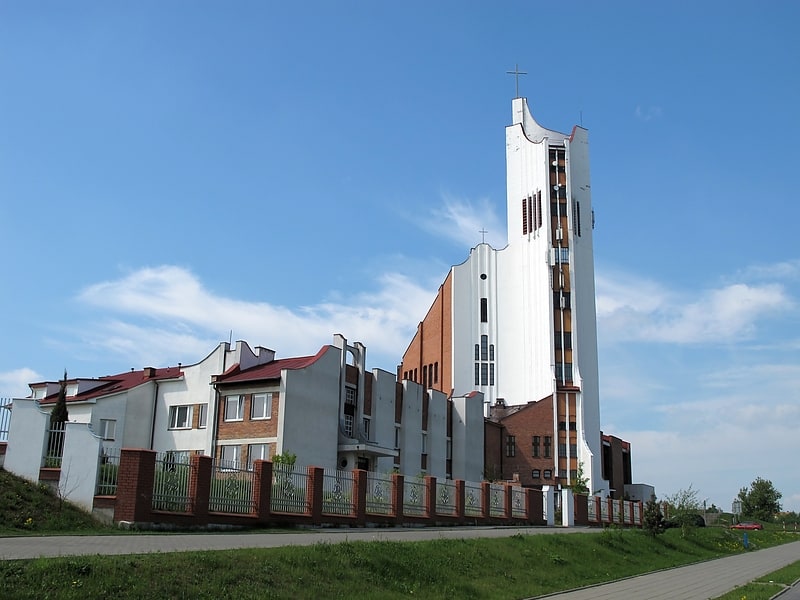
St. Hedwig the Queen Church in Bialystok - a Roman Catholic church located in the metropolitan area of Bialystok on the Słoneczny Stok estate. The church and the parish were erected on 7 February 1984.
Lipowa Street
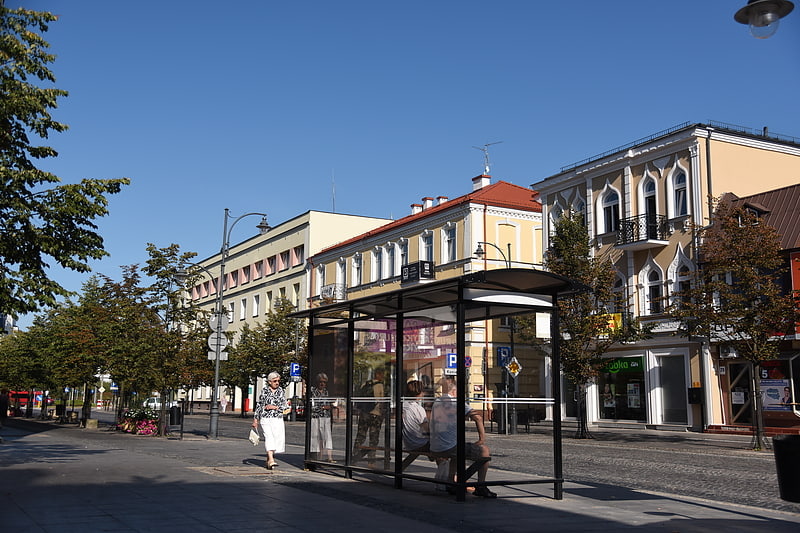
Lipowa Street is a representative street at the center of Białystok, Poland, running from the Kościuszko Square to Romana Dmowskiego Niepodległości Square. The street is made up of low buildings mostly of 2-3 floors with various shops, offices and restaurants located at the ground floor.[23]
Park Stary im. Księcia Józefa Poniatowskiego
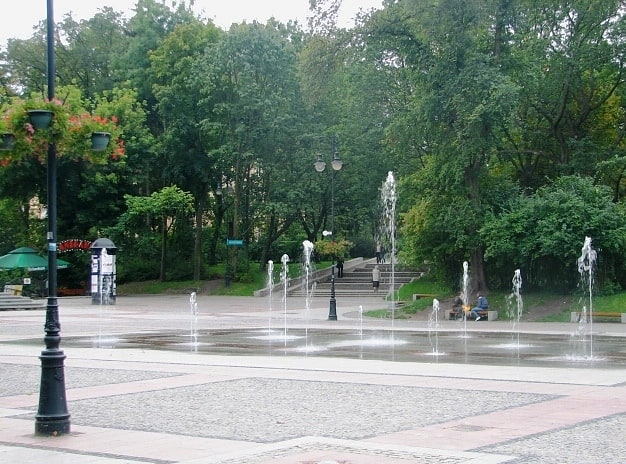
Prince Józef Poniatowski Old Park - a Bialystok naturalistic park with modernist elements. Established in the years 1895-97 on the site of the former mill pond on the Biała River, part of the composition of the palace gardens with an area of 4.76 ha in Bialystok, it was designed by Walerian Kronenberg.
Address: Plac Marszałka J.Piłsudskiego, Białystok
Białystok City Market

City market in Bialystok is a retail market located in Kawaleryjska Street 19/23 in Bialystok, Podlaskie Voivodeship in north-eastern Poland. For years it has been the largest commercial facility in the Podlaskie Voivodeship, with an area of almost 90,000 sq m. and over 2,000 permanent sales outlets.[24]